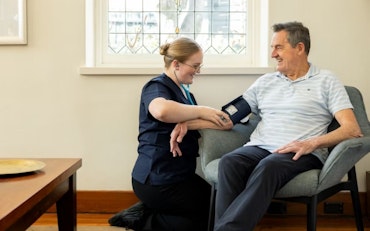New guidelines come in across Australia to keep families from falling
Falls remain one of the biggest worries for families with loved ones in aged care. A single fall can lead to broken bones, hospital stays and a loss of confidence that can be hard to rebuild. It’s a growing issue that costs Australia billions each year — but new national guidelines hope to change that.
![<p>At an older age, falls can be fatal. [Source: Daria Nipot via iStock]</p>](https://agedcareguide-assets.imgix.net/news/articles/wp/Daria-Nipot__0207.jpg?fm=pjpg&format=auto&w=550&q=65)
At an older age, falls can be fatal. [Source: Daria Nipot via iStock]
The Australian Commission on Safety and Quality in Health Care has just released updated Falls Guidelines for residential aged care services, the first major update since 2009. Backed by years of research, these guidelines focus on practical, day-to-day measures to help older Australians stay safe and independent for longer.
What’s different this time?
Unlike the old guidelines that focused mainly on ticking off risk assessments, the new approach is about real action. Care homes are now encouraged to develop individual plans for each resident, taking into account their health, lifestyle and personal wishes. It’s about preventing falls before they happen — and if they do happen, acting fast to stop it from happening again.
What can families expect?
Here are a few things you might see or want to ask about:
✓ Personalised prevention plans
Staff should regularly check for things that can increase your loved one’s risk of falling, like certain medications or trip hazards in their room. They’ll also look at ways to boost strength and balance through gentle exercise programs.
✓ Continued exercise
Movement matters; ongoing, supervised exercise is recommended, not just one-off sessions.
✓ Diet and supplements
Your loved one’s care home should ensure meals have enough protein and calcium. Many residents will also be offered vitamin D to help keep bones strong.
✓ Hip protectors
For residents at higher risk of fractures, padded hip protectors may be encouraged.
✓ Footwear, vision and hearing checks
Things like well-fitting shoes and up-to-date glasses or hearing aids can make a big difference.
✓ Safe environments
Rooms and common areas should be well-lit and free from clutter to avoid trips and slips.
✓ Quick follow-up after a fall
If a fall does happen, staff should investigate why, check for injuries properly and adjust the care plan.
Respecting choice and dignity
The new guidelines also remind providers to balance safety with independence. That means families should be involved in conversations about care plans — but so should residents themselves. Sometimes older people choose to take certain risks so they can keep doing things they love. This is called ‘dignity of risk’ and the guidelines support families and staff to respect those choices while minimising harm.
What you can do
- Talk to the care team
Ask how your loved one’s fall risks are assessed and what prevention strategies are in place. - Stay involved
Share any changes you notice in your loved one’s mobility, balance or confidence. - Speak up
If you have concerns about clutter, slippery floors or other hazards, raise them. - Ask about staff training
Ongoing training helps workers spot risks and respond quickly.
Associate Professor Jasmine Menant from Neuroscience Research Australia, who helped shape the new guidelines, said: “Falls can change someone’s life overnight — but with a team approach, families, residents and staff can work together to prevent them.”
Falls may always be a risk in aged care, but these new national guidelines are an important step towards safer, better care for the people you love most.
⇒ Find out more about the 2025 Falls Guidelines
Has a loved one ever had a serious fall? Should Australia do more to regulate the risks? Let the team at Talking Aged Care know your thoughts and subscribe to the newsletter for more information, news and industry updates.
Related content:
Have your say: in-home aged care pricing under review
Differences between respite at home and nursing home respite










